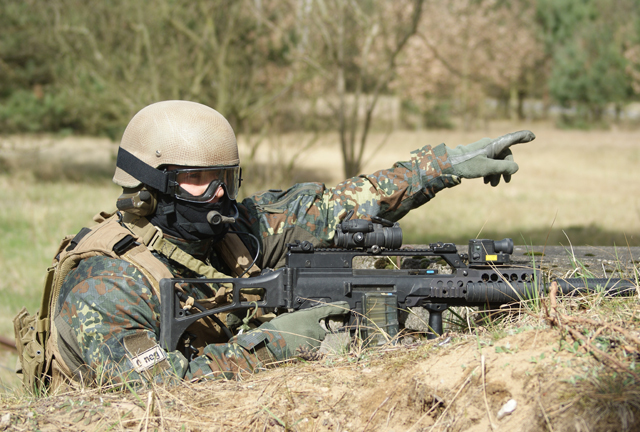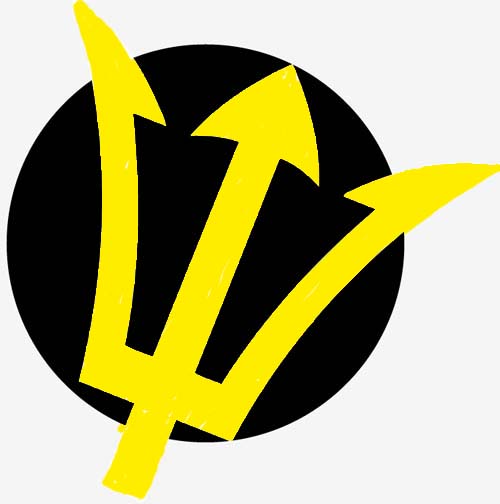
Der Ausbildungsablauf
In late 2005 the Kampfschwimmer training program was extended from 15 to 36 months. This extension reflected operational experience. It also accommodated the recent change in Kampfschwimmer rank structure. Previously sailors with the rank of Maat (equivalent to US Navy Petty Officer 2nd Class) or above could serve as Kampfschwimmer. That was changed. Now the lowest serving rank within the Kampfschwimmer Company is Bootsmann (equivalent to USN Petty Officer 1st Class or Royal Navy Petty Officer). This required adding NCO training elements into the Kampfschwimmer program so that lower ranking trainees could be promoted upon completion of their special operations training.
The three year Kampfschwimmer training program is divided into Specialty Course 1 (12 months) and Specialty Course 2 (24 months).
Der Fachlehrgang 1 – Specialty Course 1
This 12 month program is designed to select qualified candidates for Kampfschwimmer training and provide them intensive initial training. It consists of five consecutive stages.
Kampfschwimmervorausbildung (Hallenausbildung) – Combat Swimmer Pre-Training (Natatorium)
This 5 week training program conducted in the natatorium or indoor pool facility takes the candidates to their limits. This stage lays the foundation for later training in open waters. Candidates swim underwater daily to prepare them for more intense dive training provided in later stages. Both time and distance underwater are recorded.
During the first part of this stage the candidates practice: the basics of free diving as well as diving with goggles, snorkel and fins; tactical conduct underwater; and many exercises designed to getting the candidates used to operating underwater. These require the trainees to overcome inner barriers, but develop their self confidence and under water skills.
The second part of this stage is focused on tactical diving using the LAR V Advanced closed rebreather system manufactured by the German firm Dräger. Diving with this device is a completely different experience from diving with compressed air. It requires getting used to, and operating the equipment demands a lot of skill. Practice includes diving under tactical conditions, emergency ascent and emergency procedures, jumps, and exiting submarines via flooded torpedo tubes. (These capabilities are a prerequisite for participating open ocean training later.) Diving at night and nightly alert drills are also part of this stage. In addition the sailors undergo a structured physical fitness program which includes learning swimming techniques. This fitness training is conducted and supervised by athletic instructors assigned to the naval training company of the German naval special operations command. Parallel to this fitness regimen, the candidates must repeat their initial physical screening test several times to document their progress. This training stage also includes education about the equipment used. Candidates also learn about dive medicine and receive expanded combat medic training. All of these latter training elements require both written exams and practical demonstrations by the trainees.
Kraftbootführerschein – Boat Operations
Training to operate military boats is also conducted by the training company. It includes theoretical elements such as collision avoidance rules or the basic SOLAS (Safety of Life at Sea) principles, as well as hands on training elements. Both theoretical and practical training elements require final exams.
Sprenghelferlehrgang mit Tauchereinsatz – Underwater Demolition Assistant Training
Demolition assistant training is conducted by the training company. Experienced underwater mine warfare specialists train the candidates in handling and usage of explosives and detonators on land and in the water. The training course includes classroom lectures and applied training. Again, theoretical and practical knowledge are both tested at the end of the course.
Einsatzausbildung/Freiwasserausbildung – Operational Training/Open Water Training
The second training section specifically focused on combat swimmer capabilities is a 12 week course which teaches the complete spectrum of operating in water. All delivery and operating techniques are systematically introduced. The emphasis is placed on underwater operations. The curriculum begins with orientation exercises in port and progresses to long-distance underwater approach tactics. By the end of this training section, candidates are able to approach from a distance of up to three kilometers and locate a small buoy – just a few centimeters in diameter – without surfacing.
Nighttime dives, nighttime alerts, long-distance swims and the notorious Friday run are also hallmarks of this training section. The section concludes with a 30 Kilometer run and a 30 kilometer swim.
Kampfschwimmertaktikausbildung – Combat Swimmer Tactical Training
The tactical training stage encompasses the basics of land warfare, close quarter combat (CQC), forced entry, opposed boarding, long-range amphibious approach via kayak or inflatable boat, ingress and egress via the Special Boat Group, as well as advanced hand-to-hand combat training. During this twelve-week training segment the trainees live almost exclusively in the field, returning to barracks only on weekends. Water is their constant companion. A daytime or nighttime orientation march is conducted daily. This training segment wraps up with a ten day field exercise shortly before Christmas.
Recognition of Existing Qualifications
If candidates entering the Kampfschwimmer training program already possess qualifications which are on the curriculum – e.g. if they have already graduated from the non-commissioned officers course or already are certified to operate combat vehicles or boats – they do not need to repeat those courses. Instead, they are assigned to other courses while the rest of their Kampfschwimmer candidate class goes through that particular training segment.
Der Fachlehrgang 2 – Specialty Course 2
During Specialty Course 2 the candidate will qualify to become a Kampfschwimmer Boatswain (Kampfschwimmerbootsmann). Those who have not yet completed the NCO academy or other prerequisite professional development programs will attend those programs at the beginning of Specialty Course 2.
Unteroffizierslehrgang 1/2 – NCO Academy 1/2
Junior enlisted personnel will complete non-commissioned officers training at the naval NCO academy at Plön.
B, C, E Führerscheine – Military Drivers License
Training to operate various categories of military vehicle is conducted at the relevant armed forces driving schools.
Einzelkämpferlehrgang (EKI) in Hammelburg – Ranger Training
A four week program which teaches candidates to lead a unit cut off from friendly forces. Topics include: living off the land, orientation behind enemy lines (escape and evasion), traversing difficult terrain, recovery by own forces.
Fallschirmsprungausbildung mit automatischer Schirmöffnung – Static Line Parachute Training
A four week training course at the airborne/airmobile school in Altenstadt teaches candidates static line parachute operations from aircraft operated by the German armed forces.
Tauchereinsatzleiterschulung – Dive Operations Leadership School
An eight week program which trains the candidate to lead dive and reconnaissance operations.
Training is conducted using compressed air and rebreather systems. Theoretical and practical training teaches the various approach, search and reconnaissance techniques; trainees also learn to act as mission leader during dive operations. Every Kampfschwimmer must be capable of leading small unit aquatic missions.
Sprengleiterausbildung – Demolition Leader Course
Three week course conducted by the training company. Experienced underwater mine warfare personnel teach candidates to lead demolitions operations above and below water.
Kampfschwimmerkampftruppführer Teil 1-4 – Squad Leader Training
A 12 week course providing expanded training in land warfare and firearms (reactive shooting, selective shooting), entry tactics (structures and ships), cooperative tactics with aircraft and watercraft, and mobility training (use of tactical vehicles such as the MOWAG Eagle V and Quad). Candidates participate in planning and execution phases of complex and combined scenarios. The goal is to impart the skills and knowledge required for real world operations, and to train the candidate to become a thinking and efficient operative capable of filtering out extraneous information and distractions.
Sanitätslehrgang für spezialisierte Kräfte – SOF Combat First Responder Training
A four week combat medicine course taught at the Special Operations Training Center at Pfullendorf. The curriculum is focused on recognizing and alleviating life-threatening conditions, ensuring effective treatment for wounded personnel under tactical conditions. In addition to emergency procedures the course covers anatomy, physiology, pathopsychology, traumatology and dispensing of medications. Trainees are inserted into tactical scenarios and must demonstrate their theoretical and practical knowledge and skills. Internationally this training is referred to as Combat First Responder B. Training is conducted in accordance with the Tactical Combat Casualty Care guidelines.
Überlebenslehrgang für spezialisierte Kräfte – SOF Survival Training
A four week survival course at the Special Operations Training Center at Pfullendorf. Soldiers are taught the basics of surviving behind enemy lines and resisting enemy interrogation. The course consists of one week of theoretical and practical training, followed by a three week field exercise.
Fallschirmsprungausbildung mit manueller Schirmöffnung – Advanced Parachute Training
A four week free fall course at the airborne/airmobile school in Altenstadt. High Altitude Low Opening (HaLo) und High Altitude High Opening (HaHo) techniques are taught. Trainees learn to execute HaLo/HaHo jumps with full gear and additional loads, at night using night vision equipment.
Luftlandeeinsatzverfahren – Airmobile Techniques
Two weeks of instruction in repelling /fast-roping from helicopters, conducted at the airborne/airmobile school in Altenstadt. These techniques are required for insertion into rough terrain (e.g. mountains, forests) and onto ships.
Bau von Sicherungsanlagen – Mountaineering Safety
A two week course taught at the mountain and winter warfare school in Mittenwald. Trainees learn to prepare repelling stations, rope bridges and zip lines in order to safely traverse difficult terrain, and must demonstrate their proficiency in these techniques.
Englisch Lehrgang
A 12 week English course at armed forces schools, ending with a proficiency test. Passing this language course is a prerequisite for every Bootsmann.
Additional Courses of Instruction as Alternatives or Complementary to Standard Kampfschwimmer Training Elements:
Absetzerlehrgang – Jumpmaster Training
A four week course at the airborne/airmobile school at Altenstadt. This course trains the jumpmasters assigned to German military aircraft. Jumpmasters are responsible for the safe and successful execution of jump operations.
Patrole Course
A four week practical planning course conducted at the International Wing of the Special Operations Training Center in Pfullendorf. Operational planning procedures for team level missions are taught in accordance with the Military Decision Making Process (MDMP). The course is taught in English and includes international participants.
Platoon Commanders Planing Course
A four week theoretical planning course conducted at the International Wing of the Special Operations Training Center in Pfullendorf. Operational planning procedures for platoon level missions are taught in accordance with the Military Decision Making Process (MDMP). The course is taught in English and includes international participants.
Combined Joint Special Operations Planing Course
A two week week theoretical planning course conducted at the International Wing of the Special Operations Training Center in Pfullendorf. Staff level leadership procedures for special operations are taught in accordance with the Military Decision Making Process (MDMP). This course includes only German participants, but from all branches of service. The course is conducted in English, and ends with a final exam.
Rettungssanitäter/Rettungsassistent – Para Medic/Para Medic Assistant
Courses taught at military hospitals to teach emergency medical procedures. This is one of the few qualifications which service members can use professionally after leaving the military.
Finally, some specialized courses normally taken after graduation from Kampfschwimmer qualification can be taken early, in order to better utilize training time once assigned to the Kampfschwimmer Company.




